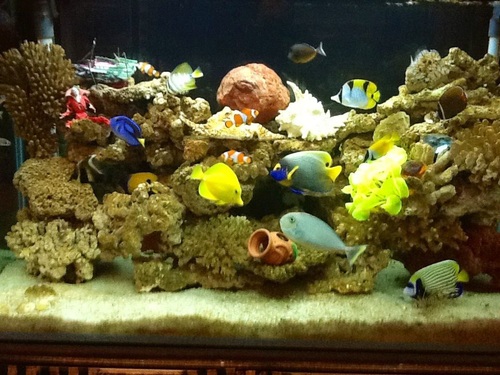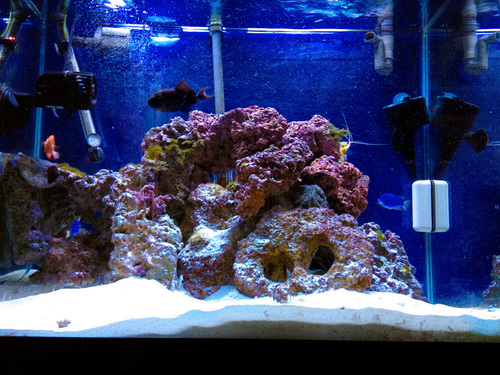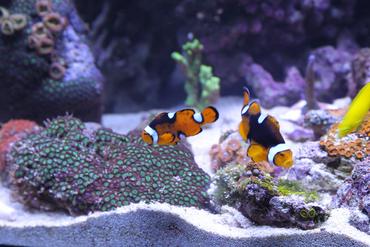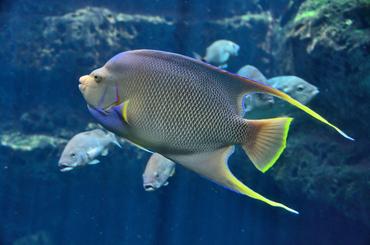TYPES OF SALTWATER TANKS: FISH-ONLY, FOWLR AND REEF TANKS

Updated
There are several different types of saltwater aquariums to choose from and each has its benefits and drawbacks. Before you make your choice, learn the basics about each type.
If you are considering starting a saltwater aquarium you have many difficult choices ahead of you. Not only do you need to decide what size tank you want, what type of fish you want to cultivate and what equipment you will use but you also have to think about what type of tank is right for you. When it comes to cultivating an aquarium you have to think about more than just “freshwater” or “saltwater”. The freshwater aquarium category can be divided into a number of different tanks including tropical, cold water and biotope tanks. Saltwater aquariums are no different – there are at three main types of saltwater aquariums to choose from and many more specific options within those categories. Before you go out and start making plans for your tank, take the time to learn about the different types so you can make an informed decision regarding which type of tank is right for you.
Distinguishing Between the Types
You may be tempted to think that a saltwater tank is a saltwater tank – all that makes them different is the type of fish you cultivate. While this may be true in the general scheme of things, it is not really quite that simple. There are three main types of saltwater tank – fish only, fish only with live rock (FOWLR) and reef tanks. Each of these three categories can be further divided or specified but, for the sake of determining which type is best for you, these three are the ones you need to be familiar with.


These three types of tanks are largely distinguished by the type of tank inhabitants – not just fish. When it comes to stocking a saltwater tank there are a number of possibilities beyond just fish – saltwater tanks are often decorated with live rock or, in the case of reef tanks, live corals and other saltwater invertebrates. The basic setup for each type is similar but some tanks will require additional equipment including high-powered lighting systems, protein skimmers and additional tank accessories. The maintenance requirements for each type may vary slightly as well.
Fish-Only Tanks
A fish-only tank is perhaps the most basic type of saltwater aquarium because all you have to worry about is fish – you do not need to install additional equipment to meet the needs of corals and you do not need to worry about cultivating live rock. Not only is this type of tank one of the most basic, but it is also the least expensive of the three. Although the setup may be simple and the start-up less expensive, cultivating a fish-only tank is not necessarily the easiest option of the three. One of the most important aspects of maintaining any kind of healthy aquarium is establishing and maintaining the nitrogen cycle – the process through which beneficial bacteria in the tank break down toxins like ammonia into less harmful substances. In a FOWLR or reef tank there is a greater colony of beneficial bacteria and other organisms to help speed this process along. In a fish-only tank, however, it may take longer for the nitrogen cycle to become fully established.
Another thing to consider with a fish-only tank is that maintenance may be required more frequently than in a FOWLR tank. Because you do not have live rock to harbor a greater quantity of beneficial bacteria, you will need to perform more frequent water changes to keep the water quality in your tank high. If you plan to cultivate a fish-only saltwater tank it would be wise to invest in an aquarium water test kit so you can keep an eye on your ammonia, nitrite, nitrate and pH levels as a means of evaluating the water quality. When it comes to cultivating a fish-only tank there are two main types – community tanks and semi-aggressive tanks. Community tanks generally house several different species which are able to peacefully coexist while semi-aggressive tanks typically house only one species or individuals from different species.
Fish Only with Live Rock
The main difference between this type of tank and a fish-only tank is the addition of live rock. Live rock is a term used by aquarium hobbyists to describe rock formations which are home to various organisms and algae. These organisms are incredibly beneficial in the saltwater tank, serving as a natural means of biological filtration and helping to keep your tank water clean. The downside of adding live rock to a saltwater tank is the cost – it is generally recommended that you use 1 to 2 lbs. of live rock per gallon in your tank and live rock can cost anywhere between $5 and $10 per pound to purchase. If you want to save some money it is possible to cure your own live rock but you will also have to purchase the cultures to make your rock come to life.
When it comes to cultivating a FOWLR tank, it is a good idea to start with the largest tank your intended tank location can accommodate. Larger tanks offer a greater water volume which equates to an increased capacity to recover from mistakes – in a small tank, chemical imbalances may be disastrous while, in larger tanks, the chemicals would be more diluted and therefore less harmful. In terms of equipment, it is important to have a high-quality filtration system in place in a FOWLR tank along with a protein skimmer to help with nutrient control. The best filtration options for FOWLR tanks are wet/dry filters or sump systems.


The lighting system you choose will also be more important than in a fish-only tank because you will need extra light to facilitate the growth of the photosynthetic organisms and algae living in your live rock. It is generally recommended that you provide 1 to 2 watts of light per gallon and, if you plan to use a high-powered lighting system, be sure to install an auxiliary fan to keep the tank from overheating. When stocking your tank, do so slowly over a period of several months. Your tank will need time to adjust to the increased biological load and your fish will need time to get used to each other. Start with the least aggressive species, adding all the fish in a particular species group, and end with the most aggressive species.
One of the most challenging types of aquarium to cultivate is the reef tank. This type of tank is generally reserved for experienced aquarium hobbyists due to the requirements for excellent water quality, improved lighting and filtration, not to mention the task of monitoring water parameters on a daily basis. The focus of a reef tank is generally geared toward corals, anemones and other saltwater invertebrates – a reef tank may or may not actually have any fish in it. The focus of the reef hobbyist is generally directed toward cultivating their corals and anemones – a task which may require a great deal of daily care and attention.
Another thing to consider in regard to reef aquariums is the high start-up cost. In addition to purchasing a large tank you will also need to invest in high-quality equipment, perhaps even a reverse osmosis unit to treat the water in your tank. In addition to the cost of equipping your tank, purchasing the corals and anemones themselves can also be very expensive. Because cultivating this type of tank requires such a significant investment, it is recommended that you do a great deal of research before embarking on this challenge. Even a simple mistake in regards to water quality can have devastating (and costly) effects on your reef tank so it is important that you are properly educated if you plan to undertake this kind of challenge.
Other Considerations

In addition to these three types of tanks there is one more type of saltwater tank you might consider – the nano tank. A nano tank is simply a small aquarium, typically less than 30 gallons in capacity. These tanks can be used to cultivate traditional saltwater inhabitants or they can be turned into miniature reef environments. This type of tank is particularly difficult to maintain, largely due to the limited water volume. Not only do you need to pay close attention to your water parameters in a nano tank but you also need to be conscious of how you stock the tank – you will need to limit the size of your tank inhabitants to fish that grow no larger than 2 or 3 inches and to corals that grow slowly. This type of tank is recommended for experienced aquarium hobbyists but, as is true of any type of aquarium, all you really need in order to be successful is the right knowledge and equipment. If you perform the necessary research beforehand and take the time to set up your tank correctly, you should have no trouble.
Non-Conventional Tank Inhabitants
Whether you decide to cultivate a Fish Only, a Fish Only with Live Rock or a Reef Tank, you always have the option of adding tank inhabitants other than fish. If you choose a reef tank, of course, you will be adding things like corals and anemones, but you have many more options to consider as well. Some of the most popular non-conventional tank inhabitants for saltwater tanks include snails, crabs, and shrimp. Some of the less common saltwater invertebrates include lobsters, scallops, cucumbers, sea slugs, sponges, and sea urchins. Each of these invertebrates provides its own unique set of benefits for the saltwater tank as well as its own set of challenges. Below you will find a simple overview of each of these saltwater aquarium inhabitants:
- Snails – There are over 40,000 different species of snails on the planet and many of them live in marine environments. Saltwater snails make excellent scavengers in the aquarium because they burrow into the gravel to feed on accumulated detritus and they eat various forms of algae as well.
- Crabs – There are a number of different crabs that can be kept in the saltwater aquarium including hermit crabs, arrow crabs, horseshoe crabs, and more. Not all crabs are reef-safe so, if you have a reef tank you need to be careful about which type of crab you choose. Most species are scavengers, feeding on detritus and some forms of algae in the aquarium.
- Shrimp – Not only do saltwater shrimp help to control detritus in the tank, but they can make for a colorful addition to the saltwater tank as well. Shrimp come in a variety of colors and sizes – you need to be careful with some of the larger species because they will feed on small fish.
- Lobsters – Like shrimp, lobsters tend to inhabit the sandy bottoms of reef tanks, burrowing themselves in the substrate and hiding in the crevasses of rock formations in the tank. Lobsters are typically nocturnal creatures, coming out to feed at night, and they can be fairly aggressive toward others of their kind.
- Scallops – These invertebrates are filter feeders which means that they sift through substrate and gather microorganisms from the water in the tank to feed. Scallops can be very tricky to maintain in the saltwater aquarium.
- Cucumbers – This type of invertebrate is best kept in either a reef tank or an invertebrate-only tank. Sea cucumbers are very sensitive to water quality.
- Sea Slugs – These invertebrates are incredibly unique and interesting to keep in the saltwater tank. They come in a variety of colors and they typically do best in reef environments.
- Sponges – Sea sponges filter their food directly from the tank water so they may need additional supplementation in order to thrive. These invertebrates need to be anchored to rockwork and they do not do well in sandy substrate.
- Sea Urchins – Most sea urchins grow between 2 and 3 inches in diameter, though their spines can be much longer. These invertebrates can help to control algae and detritus buildup in the tank.
Nothing can compare to the beauty of a thriving saltwater aquarium – saltwater fish are some of the most colorful creatures in the world and corals and anemones are a wonderful sight to behold. If you are looking for a way to challenge yourself as an aquarium hobbyist, you may want to consider starting a saltwater tank. You should be aware, however, that saltwater tanks can be more challenging than freshwater tanks to cultivate. Not only do you need to invest in additional equipment, but you may also have to pay closer attention to your water parameters to ensure high water quality. If you prepare yourself with the proper knowledge before you embark in this journey, however, you will be greatly rewarded with a beautiful and thriving saltwater aquarium.































































































